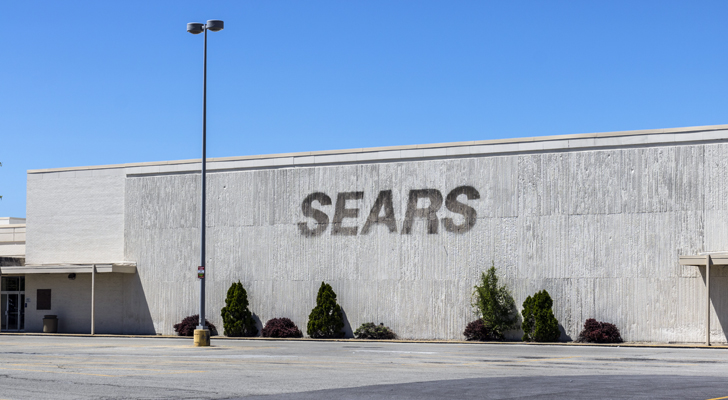The game may not be over just yet, but for all intents and purposes, it’s the bottom of the ninth. Sears (NASDAQ:SHLD), once the world’s biggest retailer, has finally succumbed to competitive pressures dished out by the likes of Amazon (NASDAQ:AMZN) and Walmart (NYSE:WMT), and to a series of misguided decision. The company filed a chapter 11 bankruptcy petition on Monday, sending SHLD stock back to record-low levels reached just a few days earlier.
Although the retailer ultimately plans to keep most of the Sears and Kmart stores open as it restructures, it’s likely that the Sears stock still trading will soon lose all of its value. Creditors and bondholders enjoy first dibs on whatever value can be extracted by a liquidation or the company’s continued operation, but total liabilities exceed total assets by a ratio of almost two-to-one. The longer the company remains in operation, the more losses it’s able to incur.
The Backstory on Sears’ Demise
Nobody can be truly surprised. The company hasn’t turned a full-year profit since 2010, and Sears has seen revenue dwindle every year since 2006.
That peak took shape shortly after hedge fund manager and then-eventual (and now former) CEO Eddie Lampert purchased struggling Kmart out of bankruptcy. Wall Street mostly cheered the deal-making, agreeing that pairing the two companies up offered a glimmer of hope for growth that hadn’t shone in a long while. The merger even prompted comparisons of Lampert to legendary investor Warren Buffett.
In retrospect, the deal and the insistence from Lampert that he takes over as CEO in 2013 would largely seal the company’s fate. He had no real experience running a retail operation at a time when even seasoned veterans were struggling to compete with the dominance of Walmart and the growth of Amazon.com.
Rather than grow or even creatively defend its turf, Lampert chose to sell the company’s most marketable real estate and its best revenue-bearing assets. As of 2010, there were more than 3500 Sears and Kmart stores (combined) in operation. As of the most recent tally, there were about 700 total units still up and running … more Sears than Kmarts. Along the way, the company spun off its Lands’ End (NASDAQ:LE) brand to raise cash and recently sold its Craftsman brand of tools to Stanley Black & Decker (NYSE:SWK).
By now, most owners of SHLD stock recognize the company should have been playing offense rather than defense.
Too Little, Too Late
Fast forward to Monday, when the retailer officially filed for chapter 11 bankruptcy protection — a form of bankruptcy petition that’s intended to restructure a company’s debt so that its debt burden is made more affordable. Sears intends to shutter 142 unprofitable stores before the end of the year, in addition to the 46 stores the organization had already informed SHLD shareholders and employees back in August would be shutting down in the foreseeable future.
Time is of the essence, for multiple reasons. Chief among them is the sheer amount of debt coming due within the next twelve months. Of the $11.3 billion worth of liabilities on the books, $4.3 billion worth of debt has to be paid back in full within a year. The retailer’s only got $6.9 billion worth of assets, most of which aren’t liquid.
Successful chapter 11 proceedings will wipe away a significant portion of that total debt, though the company’s lenders, creditors and even its vendors will have to fight even a reduced amount of money owed to them.
Even then, though, it’s not entirely clear that a smaller and less debt-laden Sears will be built to last. The company’s online and omnichannel presence is still lacking, and the retailer has been irrelevant for so long, many consumers have gotten out of the habit of even letting the company compete for its business.
Bottom Line for SHLD Stock
As for Sears stock itself, it’s tempting to scoop up some shares on the cheap here in anticipation that the post-bankruptcy company will be healthy, and offer a shot at growth. That’s not apt to be what’s in the cards, though.
Most likely, any restructuring will completely end trading in the currently traded SHLD stock, zeroing out current owners. Existing shareholders only have a claim to any residual value, and as the math of the liabilities and assets makes clear, there will be no residual value. Any new Sears stock, if there is one, will likely only be owned by new buyers bringing new money to the table.
Even that’s only a remote possibility, though. Most likely it will be a private equity outfit or another publicly traded company that ends up buying the Sears name and (maybe) whatever stores remain in operation. And even then, it seems unlikely the Sears company as we once knew it will ever thrive again.
As of this writing, James Brumley did not hold a position in any of the aforementioned securities. You can follow him on Twitter, at @jbrumley.

